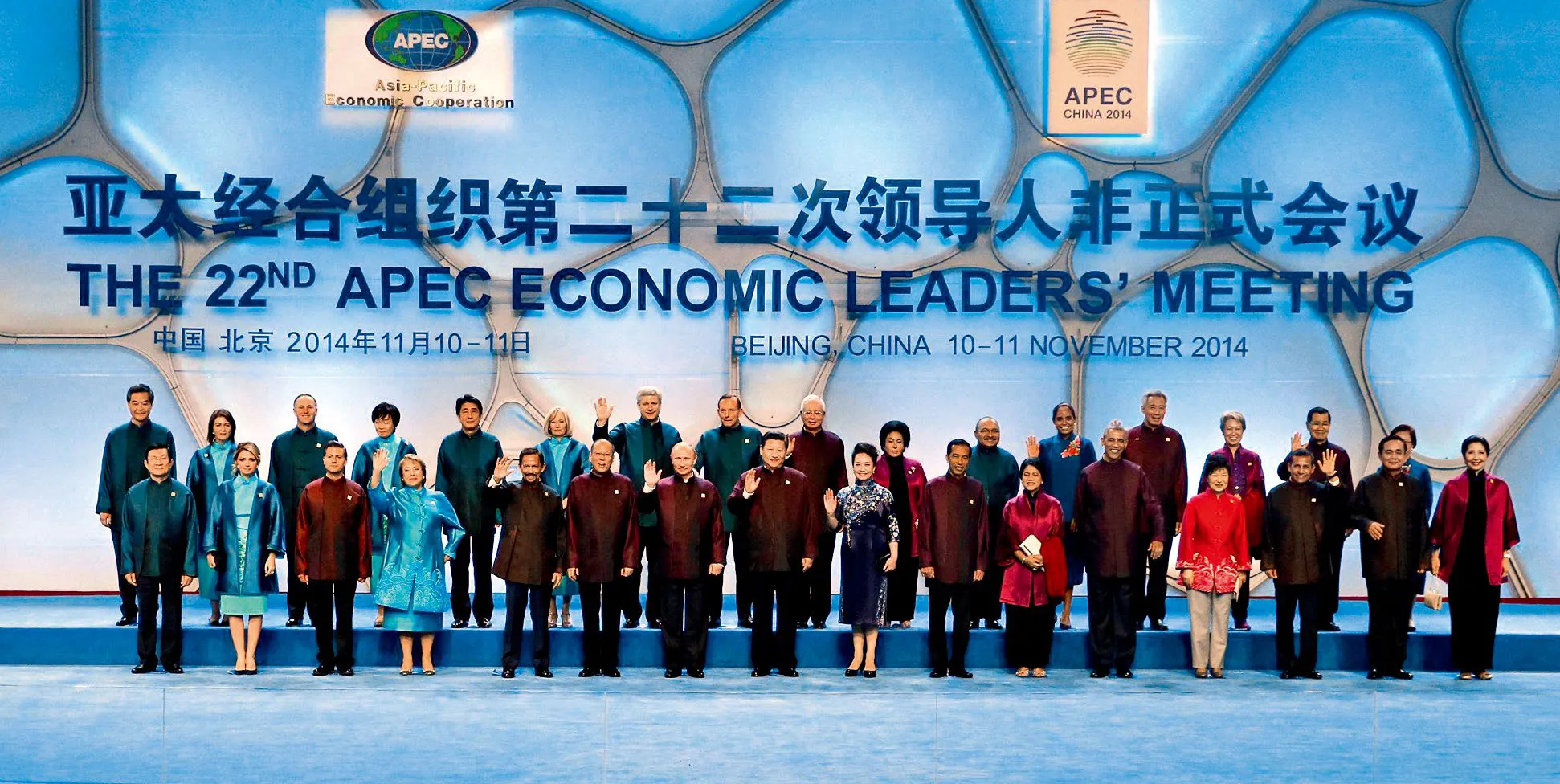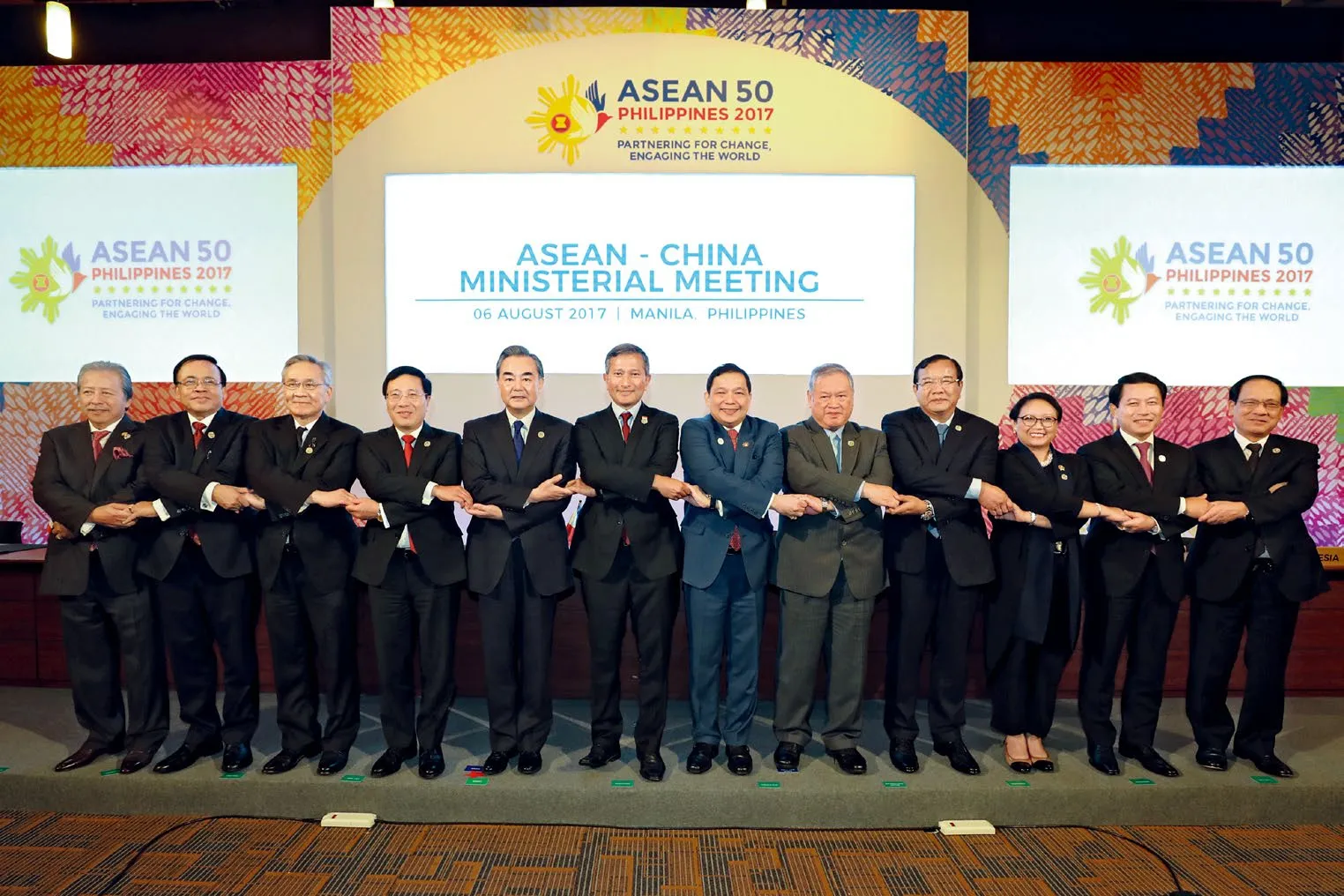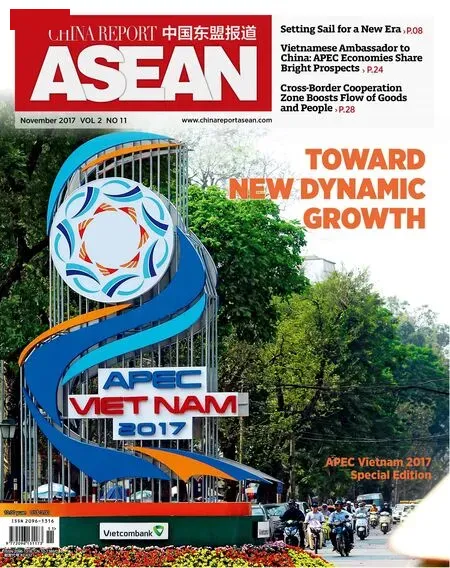EVOLUTION THROUGH COOPERATIVE COMPETITION
2017-11-22ByWangPeng
By Wang Peng
EVOLUTION THROUGH COOPERATIVE COMPETITION
By Wang Peng
Over the course of the past 30 years, China, ASEAN and APEC have grown together thanks to common goals and despite conflicting interests

Chinese President Xi Jinping and his wife Peng Liyuan pose for a photo with other APEC economic leaders and their spouses in Beijing on Nov.10, 2014.
The vast Pacific Ocean is large enough to accommodate major powers such as China and the United States. It can also accommodate multilateral international organizations such as APEC and ASEAN.Among China, ASEAN and APEC, there are both common ground and differences, as well as common goals and visions and conflicting interests.
They have evolved together in competition and cooperation over the last 30 years.
Compatible Goals and Orientation
APEC was founded in 1989.It is the most influential official forum for economic cooperation in the Asia Pacific region, consisting of 21 member economies and three observers.
ASEAN was founded in 1967. Seven ASEAN member states — Indonesia, Malaysia,the Philippines, Singapore,Thailand, Brunei and Vietnam— are APEC members, making up one-third of APEC’s membership.
Since China joined APEC in 1991 (Hong Kong SAR and Chinese Taipei joined as member economies in the same year), it has played an increasingly important role in the organization. In 2001 and 2014, China successfully hosted APEC summit meetings and contributed Chinese solutions with Chinese features to the forum. Meanwhile, since 1997,China-ASEAN cooperation mechanisms, such as 10+1,10+3, the Leaders’ Meeting and the ministerial meetings on diplomacy, finance,commerce, agriculture and forestry, tourism and labor,have vigorously propelled cooperation in different areas.
The goals and orientation of ASEAN and APEC are highly compatible and the operation and cooperation mechanisms of the two are also compatible to a certain degree. Therefore,generally speaking, the building of an ASEAN Free Trade Area (FTA) is conducive to APEC’s goal of trade and investment liberalization.The development of ASEAN cooperation and the APEC process are not contradictory,but mutually complementary.
China played a constructive role in ASEAN’s competition and cooperation with the United States,Japan and other developed APEC members.
ASEAN’s One Voice Within APEC Framework
The total area of 10 ASEAN member states is 4.44 million square kilometers, with a total population of 620 million. In 2015, ASEAN’s GDP was US$2.43 trillion, its total volume of trade being US$2.6 trillion,making it the world’s sixth largest economy.
However, in comparison with such APEC economies as China, Japan and South Korea, or other multilateral international organizations within the APEC framework such as NAFTA, ASEAN is often seen as a medium-scale regional economic bloc. As a regional organization of developing countries, ASEAN has to carefully consider how to have more discourse within the framework of APEC.
Back in 1990, one year after APEC’s founding, ASEAN had a meeting in Kuching, the capital of Sarawak, Malaysia,and endorsed the “Kuching Consensus”, the purpose of which was to coordinate the position and action of ASEAN member states internally in order to deal with the possible impact and challenges of other regional cooperation organizations.
The “Kuching Consensus”aimed to emphasize ASEAN’s initiative and dominance,opposing APEC’s dilution of ASEAN’s irreplaceable status and role in this region. The ASEAN member states at the meeting believed that APEC should neither be a forum for negotiations,nor an institutionalized official organization, but a forum for consultation.ASEAN countries would like to benefit from APEC while trying to avoid homogeneous competition with APEC.They would like to enhance their economic and trade cooperation with other APEC members while maintaining their independence and their economic and trade connections with other regions.
After the APEC summit in Seattle in 1993, the Clinton administration strengthened its engagement with APEC.Since then, the United States has tried to gain greater dominance within the APEC framework, either in its agenda or the institutionalization of the organization. Additionally,the United States and other developed APEC members have tried to increase their share in the ASEAN market in the name of trade and investment liberalization.
In contrast, the ASEAN model of cooperation features regional economic integration,which is obviously more open, inclusive and diverse.On the one hand, it has strengthened the integration among its member economies,and on the other hand, it has prudently promoted economic integration with its partners outside the region. What’s especially important is its emphasis on“respect for diversity in the Asia Pacific region”, which has somehow cushioned the effect of external forces on the institutionalization of APEC. At the same time, it has protected emerging industries being cultivated and fostered in the region.
China played a constructive role in ASEAN’s competition and cooperation with the United States, Japan and other developed APEC members.China has not only responded to ASEAN’s views on norms, but also provided a broad market.APEC’s highly internalized cooperation norms, such as“mutual respect, autonomy and free will”, “consensus,equality and mutual benefit”,“coordinated unilateral or collective action” and“recognition and protection of diversity, flexibility, step-bystep progress and openness”,all date back to the “Asian Way”first proposed by ASEAN. All these norms have also received strong support from China.
Competition for ‘ASEAN Advantage’

Chinese foreign Minister Wang Yi(fifth left) links arms with his counterparts at the ASEANChina Ministerial Meeting in Manila on Aug. 6, 2017.
ASEAN’s unique geographical advantage makes it a subject for “competition”by APEC and other major economies in East Asia and the Pacific-Indian Ocean region. Since the 1990’s,ASEAN has worked hard on East Asian regional economic cooperation. In comparison with other similar cooperation organizations in the vicinity,ASEAN has done better in achieving a series of regional cooperation mechanisms with itself as the center and dominant force. Upon entering the 21st century, China,Japan, South Korea and other countries were more keenly aware of ASEAN’s tremendous economic potential. To meet the needs for development,cooperation and competition,they raced to sign FTAs with ASEAN or its member states.It was in this sophisticated process of cooperative competition (co-opetition) that East Asia and the Asia-Pacific region at large stepped onto the new stage of high speed development and realized coevolution.
In 2002, China took the lead in signing a framework agreement with ASEAN on the “10+1 FTA”. It was generally believed that this agreement was a major move of strategic significance for China to fully participate in regional economic and trade cooperation.
After that, a series of chain reactions occurred. In 2012,negotiations kicked off on the Regional Comprehensive Economic Partnership (RCEP)— an FTA that covers ASEAN and China, Japan, South Korea,Australia and New Zealand, in effect a trans-Pacific-Indian Ocean FTA that if completed,would be the world’s largest free trade area.
China-ASEAN Cooperation
According to the IMF’s official data, the GDP of ASEAN,which is now 50 years old, had reached US$2.7 trillion by April 2017, 9 percent of the world’s total of US$29.9 trillion. It’s clear that as a vital regional organization, ASEAN is taking on a prominent position in the economic landscape of APEC and the world at large.
At the same time, APEC is turning 30. This vast network of 21 member economies is home to two-fifths of the world’s population, half of global trade (US$16.5 trillion)and 60 percent of the world’s economic aggregate. It’s selfevident that APEC is taking on a dominant position in global economic recovery and globalization.
The “East Asian community of a shared future”that President Xi Jinping proposed on diferent occasions in recent years are not empty words.
In its 30-year journey, as a long-term mechanism,APEC has played a major role in promoting trade and investment liberalization and globalization — lowering average tariffs among its member states to 5 percent,for example. Meanwhile, as a crisis-management tool and platform, APEC played a prominent role in dealing with the 1997 Asian financial crisis and the 2008 global economic crisis — from encouraging mutual assistance among Asian countries to expanding the economic connection among member economies,from preventing mutual trade barriers to shaping the development trend of the world economic order.
The successful 19th CPC National Congress has heralded a “new era” for China’s growth, whereas the world is facing increasing uncertainty — in major Western countries, populism prevails, protectionism and isolationism are rising and globalization is blocked.
General Secretary Xi Jinping’s report to the CPC National Congress stated explicitly that as one of the engines of world economic growth, China should “actively participate in and promote economic globalization”, and that people of all countries should “stick together through thick and thin, promote trade and investment liberalization and facilitation and make economic globalization more open, inclusive and balanced so that its benefits are shared by all.”
How then can China and ASEAN join hands within the APEC framework to achieve the goal that General Secretary Xi proposed in the report?
First, at the 2017 APEC summit in Vietnam, we should try to coordinate the interests of all member economies so as to speak with one voice.We should further promote sustainable development,open free trade and investment while remaining committed to the multilateral trading system,so that APEC can unfold the practical achievements of the major regional economic cooperation mechanism and bring tangible benefits to the people and businesses of the countries in the region. ASEAN has the motives and capability to join hands with China and other APEC members to share bright prospects, build an Asia-Pacific community that is peaceful, vibrant, self-reliant,inclusive and connected and bring opportunities of equal participation to all people and businesses.
Secondly, from a longer-term perspective, it’s an optimal choice for ASEAN, APEC and the rest of the world to work with China on the construction of the Belt and Road in order to share the benefits of its development.ASEAN is the first stop of the 21st Century Maritime Silk Road. Historically, from Maluku to Malacca, from Guangzhou to Jakarta, our ancestors were well connected and lived in peace and harmony. People of different ethnicities, different beliefs and different languages lived together in equality and harmony to create wealth and enjoy life. “Harmony in diversity” was their basic philosophy and “don’t do unto others what you wouldn’t want to have done unto yourself” was their way. Over thousands of years of hard work and mutually beneficial cooperation, they developed close, friendly ties on the basis of national integration and have eventually come together as a community.From the arguments above, we can see that the“East Asian community of a shared future” that President Xi Jinping proposed on different occasions in recent years are not empty words.The proposal has deep roots.There is an old Chinese saying that goes, “Taking history as the mirror, one can predict ups and downs.” From the mirror of history, we can see that the concept of “a community with a shared future for mankind” is like a banyan tree deeply rooted in history that has grown with time. We have to cultivate the tree with patience. When it grows up, its branches and leaves will provide shade for future generations. Its abundant fruit will benefit peoples around the world.
About the author:
Wang Peng is an assistant researcher at China Institute of Fudan University and a researcher at the Chahar Institute
